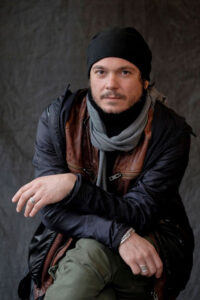
www.fabiobucciarelli.com
Fabio Bucciarelli (Italy, 1980) is a photographer, journalist and author known for his documentation of conflicts and humanitarian consequences of war. He has spent the last decade covering the world’s major events and creating images which reflect his commitment and empathy with the story, providing information focused on human rights.
Before becoming a photographer, in 2006 Bucciarelli received the MS in Telecommunication Engineering from Politecnico of Turin. He then went to Barcelona to work as an engineer until 2009 when he started to devote himself to photography.
Along with his ongoing personal projects, Bucciarelli is a frequent contributor with The New York Times. During his career he has worked for many leading publications including Time Magazine, BBC, L’Espresso, CNN, Al Jazeera, Foreign Policy, Paris Match, M Le Monde, El Pais, Internazionale, La Stampa, Il Fatto Quotidiano, La Repubblica and others.
He is the recipient of some of the most prestigious awards in the profession including The Robert Capa Gold Medal, Perpignan’s Visa D’Or News, POYi Photographer of the Year, Bayeux-Calvados for War Correspondence as well as awards from World Press Photo, POYi, BOP, Days Japan International, Sony International Photography Award and now The Lucie Impact Award 2020.
Bucciarelli’s artworks appear in several collections and his photographs have been exhibited in museums and galleries worldwide and frequently shown in International Art Fairs including Photo London, AIPAD New York, MIA Milano, Photo Basel and Zona Maco Mexico.
Alongside Bucciarelli’s projects as photographer, he has been writing dispatches for national and international newspapers and magazines and a book on the Libyan conflict called “The Dream”. In recent years he has been assigned to work as a curator and artistic director by Italian Museums and institutions.
How long have you been a photographer?
Before becoming a photographer in 2006 I have received the MS in Telecommunication Engineering from Politecnico of Turin. In 2007 I was the recipient of “Master dei Talenti”, an Engineering grants program which offered me the chance to work in Barcelona. In 2009 I quit with my engineer’s work to devote myself entirely to photography.
In the same year I started working as staff photographer for the wire agency La Presse/Ap in Italy covering breaking news. Two years later I left the agency to dedicate myself to documentary photography as a freelancer.
Who are the people, photographers, organizations that have impacted your photography? What inspires you?
I started taking a serious interest in photography in 2008 in Barcelona. During those years, the Spanish city had a fervent debate within young photographers who later became established professionals. Over the years with several of these photographers our paths crossed many times and we created projects together. In 2008 I did a workshop with Philip Blenkinsop, who influenced my professional growth.
Since I was young, my parents have often taken me to visit museums and exhibitions of great Italian and international painters. Still, part of my inspiration comes from painting and how reality has been represented in different historical times. Certainly painters of the Italian Renaissance such as Andrea Mantegna, Caravaggio between many others continue to influence my visual culture.
What do you remember was your first story you covered or photo you took that you felt had an impact?
The first armed conflict I documented was the Libyan war in 2011, during the “Arab Springs”. After covering the civil war from its initial stages in Cyrenaica, then in Tripoli and Sirte, in October I witnessed the end of Muammar Gaddafi’s dictatorship. This story and the photograph of Gaddafi the day of his death was widely published as an evidence of the end of the war.
I have continued documenting wars and revolutions in Middle East and Africa. In 2012 I went to Syria and the images from Aleppo – later recognized with several awards including OPC Robert Capa Gold Medal and World Press Photo – appeared on the front pages of leading international newspapers.
You are known for documenting war and its consequences how was this assignment different?
In all my previous experiences I did my best to report informations based on human rights, trying to create empathy with the people met in the field. My main focus has always been to translate this feeling and comprehension into iconography.
From this point of view, documenting Covid-19 in Italy was not very different. Also here, I created a contact with people who contracted the virus and their families in their intimate moments, and I try to bring back images that are to go deeper than the mainstream coverage.
The main difference it was regarding my knowledge of the Italian culture and its territory, the logistics aspects and the possibility to relate directly – without fixers – to people. This helped to build relationships that last until today.
What are you working on now?
2020 was a year of big difficulties and great challenges, also for photographers and media makers. Many of the professionals freelancers who were used to document conflicts and humanitarian crises around the world, have had to deal with the pandemic which drastically limited the possibilities of movement. 2020 was my first year of the last decade where I did not travel outside Italy. For the first time, therefore, photojournalists have turned their gaze into their country, documenting the plague of Covid-19. Since March 2020 I have been working for The New York Times in Italy, mainly in Lombardy, and I continue to work in the region.